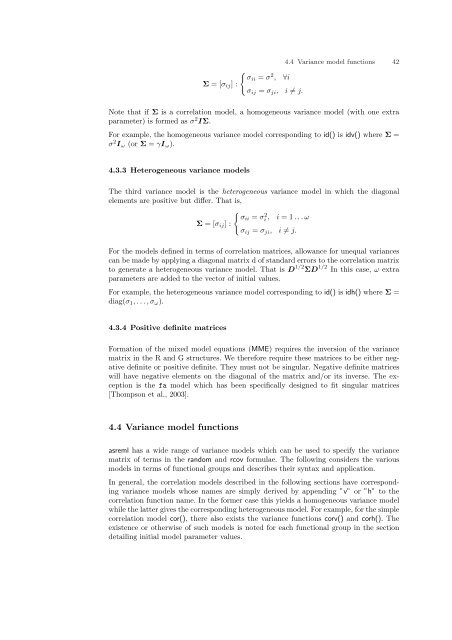ASReml-S reference manual - VSN International
ASReml-S reference manual - VSN International
ASReml-S reference manual - VSN International
- No tags were found...
You also want an ePaper? Increase the reach of your titles
YUMPU automatically turns print PDFs into web optimized ePapers that Google loves.
Σ = [σ ij ] :{σii = σ 2 , ∀iσ ij = σ ji , i ≠ j.4.4 Variance model functions 42Note that if Σ is a correlation model, a homogeneous variance model (with one extraparameter) is formed as σ 2 IΣ.For example, the homogeneous variance model corresponding to id() is idv() where Σ =σ 2 I ω (or Σ = γI ω ).4.3.3 Heterogeneous variance modelsThe third variance model is the heterogeneous variance model in which the diagonalelements are positive but differ. That is,{σii = σi 2Σ = [σ ij ] :, i = 1 . . . ωσ ij = σ ji , i ≠ j.For the models defined in terms of correlation matrices, allowance for unequal variancescan be made by applying a diagonal matrix d of standard errors to the correlation matrixto generate a heterogeneous variance model. That is D 1/2 ΣD 1/2 In this case, ω extraparameters are added to the vector of initial values.For example, the heterogeneous variance model corresponding to id() is idh() where Σ =diag(σ 1 , . . . , σ ω ).4.3.4 Positive definite matricesFormation of the mixed model equations (MME) requires the inversion of the variancematrix in the R and G structures. We therefore require these matrices to be either negativedefinite or positive definite. They must not be singular. Negative definite matriceswill have negative elements on the diagonal of the matrix and/or its inverse. The exceptionis the fa model which has been specifically designed to fit singular matrices[Thompson et al., 2003].4.4 Variance model functionsasreml has a wide range of variance models which can be used to specify the variancematrix of terms in the random and rcov formulae. The following considers the variousmodels in terms of functional groups and describes their syntax and application.In general, the correlation models described in the following sections have correspondingvariance models whose names are simply derived by appending ”v” or ”h” to thecorrelation function name. In the former case this yields a homogeneous variance modelwhile the latter gives the corresponding heterogeneous model. For example, for the simplecorrelation model cor(), there also exists the variance functions corv() and corh(). Theexistence or otherwise of such models is noted for each functional group in the sectiondetailing initial model parameter values.
















